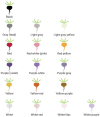Not All Maca Is Created Equal: A Review of Colors, Nutrition, Phytochemicals, and Clinical Uses
- PMID: 38398854
- PMCID: PMC10892513
- DOI: 10.3390/nu16040530
Not All Maca Is Created Equal: A Review of Colors, Nutrition, Phytochemicals, and Clinical Uses
Abstract
Maca (Lepidium meyenii, Lepidium peruvianum) is part of the Brassicaceae family and grows at high altitudes in the Peruvian Andes mountain range (3500-5000 m). Historically, it has been used as a nutrient-dense food and for its medicinal properties, primarily in enhancing energy and fertility. Scientific research has validated these traditional uses and other clinical applications by elucidating maca's mechanisms of action, nutrition, and phytochemical content. However, research over the last twenty years has identified up to seventeen different colors (phenotypes) of maca. The color, hypocotyl size, growing location, cultivation, and post-harvest processing methods can have a significant effect on the nutrition content, phytochemical profile, and clinical application. Yet, research differentiating the colors of maca and clinical applications remains limited. In this review, research on the nutrition, phytochemicals, and various colors of maca, including black, red, yellow (predominant colors), purple, gray (lesser-known colors), and any combination of colors, including proprietary formulations, will be discussed based on available preclinical and clinical trials. The gaps, deficiencies, and conflicts in the studies will be detailed, along with quality, safety, and efficacy criteria, highlighting the need for future research to specify all these factors of the maca used in publications.
Keywords: Lepidium meyenii; Lepidium peruvianum; adaptogen; glucosinolates; hormones; maca; menopause; phenotype; prostate; reproductive health.
Conflict of interest statement
All authors are independent contractors of, or have a commercial interest in, Symphony Natural Health, a commercial entity that sells a maca dietary supplement for hormone health in the retail and health professional channels.
Figures






References
-
- Meissner H.O., Mscisz A., Kedzia B., Pisulewski P., Piatkowska E. Peruvian Maca: Two Scientific Names Lepidium meyenii Walpers and Lepidium Peruvianum Chacon—Are They Phytochemically-Synonymous? Int. J. Biomed. Sci. 2015;11:1–15. doi: 10.59566/IJBS.2015.11001. - DOI
-
- WFO Genus Lepidium L. [(accessed on 24 November 2023)]. Available online: https://wfoplantlist.org/plant-list/taxon/wfo-4000021089-2023-06?page=1.
Publication types
MeSH terms
Substances
Grants and funding
LinkOut - more resources
Full Text Sources

